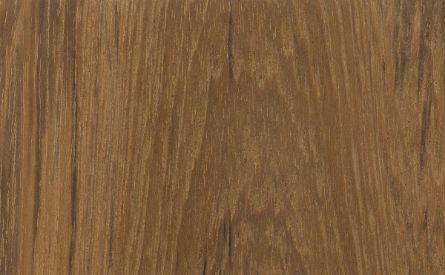Teak
Teca / Tectona grandis

Local Names
Kyun, Teck, Sagwan, May Sak
Distribution & Tree
Native to India, Myanmar, Thailand, Laos, Cambodia and Indonesia, teak’s extensively cultivated in plantations within its natural range as well as in tropical areas of Africa and Latin America. Due to over-exploitation, teak harvest has become increasingly restricted in Myanmar, which, until recent years, has been the largest exporter of natural-forest teak. Plantation teak is replacing a portion of the lost supply with significant producers including Indonesia and Malaysia. Several large plantations have been established in Guatemala where clonal advances have improved growth rates and tree uniformity. On favorable sites, trees can reach heights of 40-45 m with clear boles to 25 m. Trunks can reach 120 cm, developing flutes and buttresses with age.
Wood Appearance
Teak’s heartwood is dark golden yellow, turning a dark brown with exposure, often very variable in color when freshly machined with blotches and streaks. Its sapwood is pale yellowish and sharply demarcated. The wood’s grain is straight, sometimes wavy and its texture coarse. Teak’s silica content is variable, ranging up to 1.4%. All teak produced in Latin America is of plantation origin and therefore younger and smaller diameter than logs sourced from natural forests. As a consequence, sapwood content in American teak may be higher and strength slightly lower, depending on age and genetics.
Processing Properties
Teak is easily worked with both hand and machine tools and takes a very smooth finish. Machining is good, though tungsten-carbide implements are indicated. It glues moderately well despite its oily nature. It takes screws and nails well but pre-boring is recommended. Due to its silica content, blunting of cutters can be elevated.
Strength & Durability
Teak’s high oil content makes the wood an outstanding exterior wood. Teak’s heartwood is very durable with respect to decay fungi and termites; it’s somewhat susceptible to marine borers. It has very good dimensional stability, holding its shape well and making it attractive for boatbuilding and other uses demanding tight tolerances.
Wood Uses
Teak’s used for shipbuilding, joinery, furniture (including lawn pieces), windows, doors, cladding, flooring, carving, cabinetwork, paneling, turnery, tanks, and fixtures requiring high resistance to acidity environments.
Ecological & Social Importance
Teak is among the first tropical hardwoods to be selected and propagated. It was thought to have first been planted in the Indonesian archipelago on the islands of Madura and Sulawesi about 300 to 400 years ago and is now considered to be a naturalized species in Indonesia. In Burma, a smallholder system known as taungya was adopted as early as the 1850s based on the inter-planting of teak and food crops. Intensive teak plantations gradually expanded across the tropics when the species was introduced to Africa (Nigeria) in 1902 and the Americas (Trinidad) in 1913. By 2000, an estimated 5.7 million hectares of teak had been planted worldwide.
| Reference Species | ||||
| Technical Characteristics | Teak | Red Oak | Black Maple | |
| Density | kg/m3 | 624 | 700 | 640 |
| Janka Hardness | kgf | 500 | 553 | 535 |
| Bending Stiffness (Modulus of Elasticity) | GPa | 13.7 | 12.1 | 11.2 |
| Bending Strength (Modulus of Rupture) | MPa | 97.1 | 99.2 | 91.7 |
| Crushing Strength | MPa | 54.8 | 46.8 | 46.1 |
| Shrinkage, Radial | % | 2.6% | 4.0% | 4.8% |
| Shrinkage, Tangential | % | 5.3% | 8.6% | 9.3% |
| Shrinkage, Volumetric | % | 7.2% | 13.7% | 14.0% |
| T/R Ratio | 2.0 | 2.2 | 1.9 | |
| Values determined at 12% humidity | ||||
|---|---|---|---|---|
DENSITY
JANKA HARDNESS
BENDING STIFFNESS
BENDING STRENGTH
CRUSHING STRENGTH
SHRINKAGE
Values are for reference only and cannot be guaranteed. Wood is a natural material and physical and mechanical properties may vary depending on age, genetics, and other factors. We encourage customers to consult the references provided in the bibliography. For further explanations of wood’s key technical characteristics, an excellent resource is the Wood Database with articles on Density (average dried weight); Janka hardness; Elastic Modulus; Rupture Modulus; Crushing Strength; Radial, Tangential and Volumetric Shrinkage.






